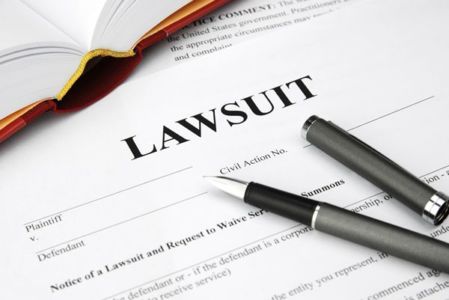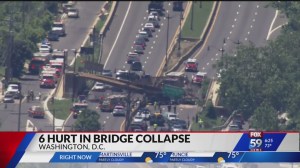The Florida Condo Collapse – Lots of Blame to Go Around
While politicians in Washington continue to play games with an urgently needed $1 trillion infrastructure relief bill the nation was hit full face with the cost of ignoring what needs to be rebuilt in this country.
The collapse of half the Champlain Towers South condo in Surfside, Florida should act as a red flag warning for us all. The trillion-dollar fix-it bill is pending because much of America, like the Champlain Towers, is in dire need of repair.
As tireless workers continue to comb through the wreckage in Florida lawsuits have already been filed by survivors. By the time you read this there will likely be more.
So far, the lawsuits point the finger of blame at the building’s condominium association and its failure “to adequately secure the building, placing the lives and property of its occupants and visitors … at risk resulting in the collapse of the building.”

Indeed, the association was given an engineering report in 2018 which found “major structural damage” in the pool area and the underground parking garage. Immediate and costly repairs were indicated.
That’s when many residents questioned paying pricey assessments to finance the $9 million job. After all, at a November 15, 2018 condo board meeting Mr. Ross Prieto, a building official from the town of Surfside, had declared the building appeared to be “in very good shape.” * What were residents to think? They had bought their unit believing the building was sound. If there were dire construction issues to be addressed surely they were the responsibility of someone else.
Then two months ago, the president of the association wrote her neighbors warning the “concrete deterioration is accelerating” and estimated the cost of repairs had jumped to more than $16 million. No repairs were underway when the building pancaked trapping some 160 people underneath tons of debris they used to call home.
But is the condo association to blame? What about the building managers, the local building inspectors, the architect or developer of the project or the construction companies that installed what developed into visibly rotting rebar and crumbing concrete? Seems there is plenty of blame to go around and that fact will surely keep the litigation in court for years.

Gregg Schlesinger is a former construction project engineer and an attorney specializing in construction defects. He says the experts should have sounded the alarm.
“The building speaks to us,” he said. “It is telling us we have a serious problem.” Schlesinger maintains the building managers, “kicked the can down the road. The maintenance was improper. These were all red flags that needed to be addressed. They weren’t.”
You’ve probably heard someone say, “Buildings in America don’t just fall down.” But they do, for a variety of reasons: older buildings not maintained, those with shoddy original design or construction, buildings with careless renovations and structures where building inspectors took bribes to look the other way when infractions were discovered. All occurred because someone didn’t do their job.
For too long municipalities nationwide have put off repairing crumbling bridges, roads, dams and other public services. If we didn’t realize it before now, we should certainly understand today, that warnings from construction experts should not be ignored. Nor should the culpable be allowed to skate. Whether they are punished through the civil or criminal courts I don’t know, but these failures will continue until the responsible are held accountable.

Late last month in Washington, D.C. a pedestrian bridge suddenly gave way and fell onto a major freeway during the lunch rush. The collapse trapped a truck carrying 500 pounds of diesel fuel. Miraculously only half a dozen people were injured.
Then recall the 13 who died and the 145 injured when a bridge in Minneapolis suddenly plummeted into the Mississippi River in 2007. Faulty gusset plates had been installed that simply could not hold the weight of rush hour traffic and construction equipment on the span that day.
While interested parties in Florida try to figure out who’s to blame for the condo collapse the rest of us might want to consider who should be held responsible for the next public works project that kills people. Is it municipal leaders who failed to find the necessary funding or is it our partisan Congress that seems to be more interested in political posturing than keeping us safe?

Martin writes:
Hello Diane,
I am not sure how the condo homeowners association can be held liable for this disaster. This group is made up of volunteers who are condo residents and not responsible for the structural integrity of the building after construction. They usually have input regarding the property management. This presents the question for any multi dwelling units: who is responsible for the building structure not included in a resident’s condo, such as common areas, pool, parking lots, and recreation areas? If they report compromises in a building’s structure and nothing is done, should they be held accountable?
They also received conflicting information from the Morabito Consultants report in 2018 that indicated major structural damage and later Ross Prieto’s assessment that the building was in pretty good shape. People should ask Mr. Prieto what compelled him to arrive at that conclusion. Even if residents wanted to initiate the repairs detailed in the Morabito report, where was the $9M to come from? The minimum amount based on condo size for repair costs was reported as $80,000 which is a large bill for a retiree on fixed income. If they choose to sell, then who would want to buy with the impending repair bill?
Residents also complained about the building structure during the construction of a neighboring high rise. Mr Prieto was requested to inspect Champlain South but his response was “Ther is nothing for me to check”. He is currently on leave from his job.
Earlier this year another homeowner’s report was submitted about the structure with now a $15M repair cost and no action.
You also mentioned deteriorating infrastucture around the country as a serious problem. Rust belt cities are especially vulnerable since they have fewer residents and a reduced tax to address the infrastructure repairs, so the projects are further delayed.
Thank you for your article.
Kevin McKeown writes:
Diane:
Considering that a Minneapolis Police Office is basically doing life for killing one man, I think those horribly irresponsible persons you cite in “”lots of blame” should do life, and burn in the flames of hell.
Especially the engineer who gave the structural thumbs up after the 2018 report. C’mon man. As you know who likes to say.
If this happened in China, execution squads would be assembling now. I’m not kidding. I’m serious. Executions. Family shaming.
Attached is my analysis of the disaster. I sent this to my astronomy buddies. I have an engineering degree, minor in mining, including rock mechanics, bridge design, and quite a bit of experience in the risky renovation of old gold and silver mines in the west. And I worked as a concrete geotechician for sometime.
Recall that a day after the collapse, rescuers were in the basement level trying to dig upwards, underneath a highly unstable slab of concrete hovering above them. What on God’s green earth were they thinking?
Fact: no-one survived even minutes after the collapse. Tear down the sister structure. Now, dammit. If that happens with people nearby, more deaths will result.
Anyway, that’s how I see things.
Kevin
>>>
Hi all:
In a perverse way, the tragic collapse of the Surfside, Fla. highrise is analogous to a type II supernova. One aspect of the collapse, it seems, is that the buildings failed at ground level. That is, there was a core collapse. Watch the security videos carefully in slo mo. The collapse of the buildings is identical to the way a demolition company takes down an old high rise. They dynamite the ground level columns. Then the upper levels fall in with tremendous acceleration and energy (or power.) The result is a pile of really chewed up, fragmented concrete. Which is easy to clean up. Look at what the rescuers are picking through: pulverized concrete.
Curiously, the Trade Towers did not fail this way entirely. That failure involved upper levels collapsing into robust lower levels, which tried to, but were unsuccessful in braking the collapse.
In the final analysis by the experts, I think this will be their conclusion. I’ll throw this out: the dynamics of the Surfside event makes it highly unlikely anyone (save for one boy) survived the collapse immediately after it happened.
Kevin
linixon0919 writes:
Do high rise buildings have regular inspections by an agency with authority to shut it down if necessary repairs are not made?
I get the whole regulation thing, I am opposed in general, however, sometimes you need it. The problem is the greed and corruption in all things government. Besides greed and corruption there is the human element. If an inspector said you have problems that need to be addressed, and the HOA didn’t have the money, the tenants are low-mid income seniors and can’t afford an increase in their fees, what do you do? Roll the dice and think, well maybe nothing will come of this, and those people can’t afford to get it fixed? Or say, well tough luck, pay up or move out?
I don’t have the answer. Maybe it is we can’t provide for every possible emergency. However, this is not infrastructure, and these types of issues should never be considered as such. If you live in a high rise that is being overcome by water, you should be paying a lot to cover emergencies. If you have to ask how much, you can’t afford it.
Diane replies:
Sure, there are local/state building inspectors who have the authority to condemn any structure they find to be a danger to the citizenry. That didn’t happen in this case. Why not?
I’m wondering why the condo association didn’t file suit against the architect/developers/contractors long ago – when the problem was first discovered?
The entire condo board resigned amid much bickering by residents after the initial discovery of the problems…so why didn’t the new officers suggest going after those who were responsible for the apparently faulty design/construction? We may never know.
pattip1956 writes:
At this point, do you think they care? I’m sad to say that I do not think they care.
Sue Schroeder writes:
I haven’t been able to process this. It’s too terrible for words. It should not have happened.
Jim Reynolds writes:
As soon as enough Congressmen remove their heads from their “politically motivated asses” and see the trees through the forests. We SHOULD NOT need a “9-11” magnitude infrastructure catastrophe to motivate us to action. We run up the debt to give money away to countries that do not really like us–why is it adverse to add to the debt for our oun safety & security.
Scott Wilson writes:
It will pass when there is really infrastructure in the bill instead of the green new deal pet projects of the Democrats. They have already agreed to a bipartisan bill of over 500 billion dollars that Biden said he would sign and then two hours later made republicans look like fools for negotiating with him because he had to back out of the deal he said he would sign. I guess he forgot he said it.
Phyllis Kalbach writes:
It will pass when we decide that our country and fellow citizens are more important than money.
Gordon Cucullu wrote:
Diane Dimond, One thing we can be sure of, Diane, is that most of the extravagant expenditure goes to pet leftist organizations and green new deal crap. A real infrastructure bill could easily be formulated for far less money if those in control wanted to do it. Just more attempts for political power and control. Difficult times indeed.